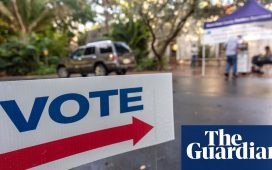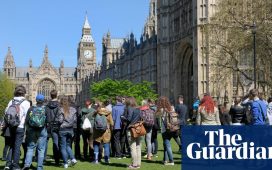Since the US supreme court banned affirmative action in college admissions in June 2023, US colleges and universities have grappled with how to boost campus diversity amid recent, troubling data.
The latest figures on US college admissions at some major universities have shown drops in Black, Latino and Indigenous first-year enrollment. Such enrollment fell sharply at elite, private colleges such as the Massachusetts Institute of Technology, Cornell University and Stanford following the ban on race-conscious admissions, according to preliminary, self-reported data. University of North Carolina at Chapel Hill, a prestigious, public university, also reported that Black and Latino student enrollment fell, by at least 25% and 7%, respectively.
Following the supreme court decision, as a means to encourage equity in the college admissions process, Carleton College, Occidental College, Virginia Tech and Wesleyan University have said they will no longer consider legacy status in admissions, a practice where a prospective student receives preference because of an alumna or alumnus relative. Additionally, several states have banned legacy admissions for public universities entirely, including Virginia, Illinois, California and Maryland.
“We’ve been working hard at wanting to create the most diverse classes possible, and recognizing that there are signals that you send to candidates about what sorts of students you’re looking for,” said Alison Byerly, the president of Carleton College. “We did worry that one effect of privileging legacy applicants would be that it sends a message that if you haven’t gone to college, specifically at our institution, you’re less valuable to us as a candidate.”
But banning the consideration of legacy status from the admissions process is not a “silver bullet” for increasing diversity at universities, said Dominique Baker, an associate professor of education and public policy at the University of Delaware and a former college admissions administrator. “Removing legacy, in and of itself, can be the ethical thing to do, and, on its own, not necessarily change the demographics of who enrolls.”
Legacy admissions have long been a practice at US universities, more commonly at private or selective universities. The practice first began at Ivy League schools in the 1920s, according to research from sociologists Deborah L Coe and James D Davidson. It was primarily used as an antisemitic policy to limit the number of Jewish students who were enrolling. Schools would weigh criteria including “good character”, namely having “proper ethnic and non Jewish affiliations”, previous attendance at private schools, and attending chapel services, Coe and Davidson wrote.
Though universities no longer explicitly discriminate against Jewish applicants in legacy admissions, many still have legacy policies to maintain alumni relations, and to secure funding from alumni, despite research disputing that legacy admissions increase donations, said Richard Kahlenberg of the Progressive Policy Institute, a liberal thinktank. Beyond boosting admissions, some schools, namely state flagship colleges, also offer scholarships solely to legacy admissions, another way of increasing that demographic.
But results on increasing diversity among students by decreasing legacy admissions have been mixed.
At Carleton College, 13.6% of admitted students had a legacy connection to the school for the 2024-25 school year versus 15.7% for the 2023-24 school year, said Byerly. Reasons behind the slight decrease in legacy students are “difficult to know without multiple years of data”, she said, possibly due to standard fluctuations in student demographics or other variables. “The fact that the change was so small tends to suggest that interest remains strong among students with Carleton connections, and that they are similar in qualifications to those admitted with legacy preference in the past.”
Carleton also observed a decrease in enrollment of students of color, from 39% in the 2023-24 school year to 33% in the 2024-25 school year, which she said was likely due to the supreme court decision, the bungled rollout of this school year’s federal financial aid program, and other factors.
At some other schools that have ended the practice, the number of legacy students is largely unchanged. Keri Risic, the executive director of undergraduate admissions at the University of Minnesota Twin Cities, said that while the school has always employed a “holistic review” within admissions, about 21% of admissions in the 2024-25 school year had a family member who attended the university, roughly the same figure as in the 2023-24 school year. “We have typically surmised that because we have 600,000 living University of Minnesota alumni, with many of them still living in Minnesota, that it’s highly likely a new prospective student will have some ties to the University of Minnesota”, said Risic.
Wesleyan University, which ended its legacy program in 2023, said it is unclear how much of an impact that action has had, in a statement to the Guardian. The school did see a slight uptick in the number of Black and Latino first-year students, increasing from 11% and 10% respectively, for the class of 2027, to 12% in both categories for the class of 2028.
Baker emphasized that legacy admissions are “one of the hardest things to get research on” as colleges do not want to publicize information on the preferential treatment.
The majority of people with generational connections to a university are wealthy and white, said Julie Park, a professor of education at the University of Maryland, College Park. And at top universities, legacy student admissions can account for up to 10-25% of college admissions, according to a 2018 report from Education Reform Now, a thinktank and educational advocacy organization.
De jure discrimination, such as segregation laws, meant that Black and Latino people were widely barred from attending many universities, thus limiting today which students of color would benefit from legacy admissions. “Who had the opportunity to attend these institutions one or two generations back?” Park asked. “Predominantly white families.”
Moreover, legacy admissions specifically benefit students who already have advantages in the college admissions process. White, wealthy students disproportionately have access to information on the college admissions process, campus tours, test prep and other application boosts.
“There are limited numbers of spots at these universities, and if you’re setting aside a certain percentage for legacy students who are disproportionately white and wealthy, then you are squeezing out capable students of color who might otherwise be admitted,” said Kahlenberg, who’s also edited a book on affirmative action.
Overall, experts said that schools have to be proactive about their recruitment of students to maintain equitable representation on campus.
Schools need to examine other parts of the application process that can create unfair advantages, including use of standardized testing or putting significant weight on a student’s advanced placement (AP) classes, courses that are disproportionately unavailable to students of color, said Sarah Hinger, the deputy director of the Racial Justice Program at the American Civil Liberties Union.
“Are schools affirmatively reaching all communities where there may be students who would be strong candidates for their school and enrich their student body?” she asked. “Are they using entry requirements that unnecessarily and unfairly exclude opportunity? For example, AP courses or even calculus may end up providing a skewed assessment of a student’s capability”.
Byerly added that Carleton has worked to improve its enrollment of first-generation students and those who are eligible for federal Pell grants, similar tactics employed by Duke University, which managed to increase Black and Latino enrollment despite the supreme court ruling.
But experts emphasized that there is not one quick fix to improving diversity, especially after the rollback of race-conscious admissions, and seeing results is also a long process.
“Institutions are definitely trying to experiment with ways to think about their recruiting, to think about their admissions review in ways that can uphold diversity while also aligning with the law,” Baker said. “Part of the challenge is most universities are not talking about what they’re doing right now because they’re not trying to be sued. There is experimentation happening, but I think it’s going to take a very long time for us to know more about it publicly.”





